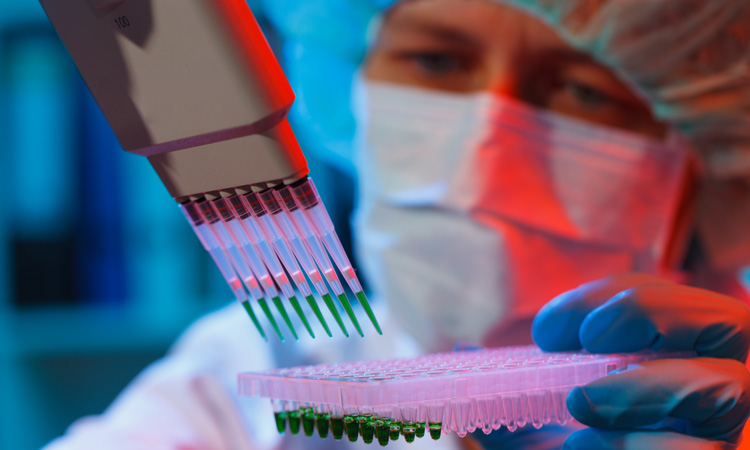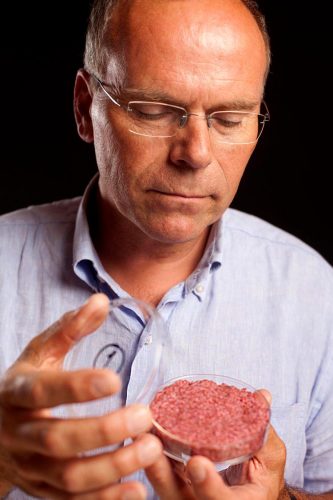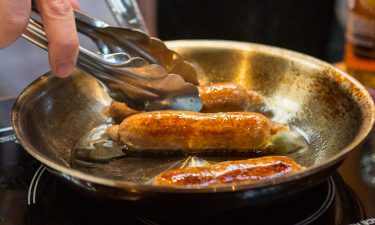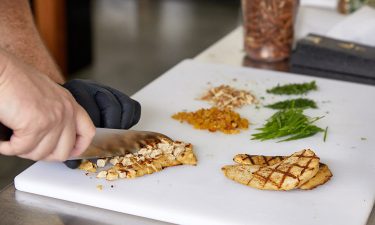Is the future cultivated meat?
- Like
- Digg
- Del
- Tumblr
- VKontakte
- Buffer
- Love This
- Odnoklassniki
- Meneame
- Blogger
- Amazon
- Yahoo Mail
- Gmail
- AOL
- Newsvine
- HackerNews
- Evernote
- MySpace
- Mail.ru
- Viadeo
- Line
- Comments
- Yummly
- SMS
- Viber
- Telegram
- Subscribe
- Skype
- Facebook Messenger
- Kakao
- LiveJournal
- Yammer
- Edgar
- Fintel
- Mix
- Instapaper
- Copy Link
Posted: 19 August 2020 | Bethan Grylls (New Food) | No comments yet
Bethan Grylls speaks to stem cell scientist, Dr Elliot Swartz, about the process of lab‑grown meat and why he believes we should embrace this technology.


Once thought the work of science-fiction, cultivated meat is quickly becoming a reality. Driven by the advent of modern-day cell culture, scientists are experimenting with the possibilities of lab-grown meat using knowledge developed in the pharmaceutical industry.
Dr Elliot Swartz, whose expertise lies in stem cell biology, is a senior scientist at The Good Food Institute (GFI), a non-profit looking to accelerate the alternative protein industry.
What is cultivated meat?
You may be more familiar with cultivated meat via its alternative names, ie, clean meat, in-vitro meat, lab-grown meat. However, Dr Swartz and the team prefer the use of ‘cultivated’ as they believe it most accurately describes the process and is a more inviting term. Whatever you call it, it is essentially meat grown from animal cells that replicate the sensory and nutritional profiles of conventionally produced meat.
We are on a good trajectory to lower the costs precipitously now and in the next five years.
“We leverage animal cell culture and tissue engineering technologies to create meat products without having to slaughter an animal,” Dr Swartz explained. “That’s one of the reasons why I work in this area: there are so many problems now associated with industrial animal agriculture, especially in the context of a growing population and a rise in meat demand. We need to devise new technologies that are able to meet this, and cultivated meat is a promising way of doing just that.”
He elaborated: “The world population is due to reach 9.5 billion by 2050 and we know that as incomes rise in developing nations, diets tend to become more meat-heavy. It is predicted that the demand for meat is expected to rise somewhere between 70-100 percent by the middle of the century. But our current levels are already having a huge impact on the Earth and human health in terms of the amount of land that’s used, greenhouse gas emissions, the risk of foodborne illnesses and zoonotic disease, as well as driving antibiotic resistance.
“We are walking down a precarious path if we continue without making changes.”
How does cultivated meat work?
There are a lot of intricacies involved in the creation of cultivated meat, but in very basic terms, the first step is to start with a high-quality source of cells. This can come from a tissue biopsy that is taken under local anaesthesia from a living animal or a tissue harvested from a recently slaughtered animal where the tissue remains viable. In either case, this very small piece of tissue is taken to the lab and the desired stem cells separated.
We are walking down a precarious path if we continue without making changes.
“A stem cell has the ability to create different cell types as well as renew and replicate itself, so ideally you want to work with different types of stems cells as the starting cell line that you are using in this process,” Dr Swartz said. “You also want to work with a large amount of stem cells so you can create the amount of biomass that will be needed to convert the meat tissue.”
He continued, “These cells are ‘grown’ in a nutrient dense medium formulation that has everything a cell needs to survive, such as glucose, amino acids, vitamins, etc. This is done using a bio-reactor, what we like to colloquially call a ‘cultivator’.” He compared it to a large fermentation tank you’d see in a brewery – but instead of producing a beverage it allows cells to grow into ‘meat’.
“Essentially, you are changing the composition of the media and switching those cells to create muscle tissue, fat tissue and connective tissues,” he explained. “You can do that in the presence of a scaffolding structure such that those cells will align themselves and form the native architecture as they would in an animal’s body. From there, you have to figure out a way to harvest, package and sell that product.”
Maintaining quality
There is no legal regulatory framework for meat cultivation, but discussions are taking place, according Dr Swartz. Currently, those working in lab‑grown meat are looking to safety precautions and quality control regulations outlined in the food and biopharmaceutical industries.


Professor Mark Post, Chief Scientific Officer at Mosa Meat, presents company’s first cultured hamburger in London, UK conference. Credit: Mosa Meat
“You need to be able to ensure that the cells being used are free of bacteria, viruses or other pathogens that can remain or be present in cellular tissue or from biopsy,” he noted. “To ensure this, all connections between the bio-reactor systems we use are sealed and sterilised.
“Additionally, you must ensure that any additives, such as the scaffolding material, is food safe or even biodegradable. Some are considering using cellulose from plants or alginate from algae.”
It is noteworthy, he added, that as the cells are being ingested rather than put into the body for medicinal purposes, there is much less risk to customers. “In our case, the cells are dead when you are eating them, they do not need to be functional. Rather, you just need to replicate the sensory and organoleptic properties of the meat tissue itself, and in doing so, there is a lot less complication to worry about from a product perspective.”
Cell selection
There are a variety of cell types that can be used in meat cultivation and the type that you choose governs a lot of the bioprocess that you are building, according to Dr Swartz.
For example, pluripotent stem cells have the ability to transform into fat, muscle and connective tissue, whereas other stem cell types come from the adult tissue itself. What this means is that you can take stem cell populations from a muscle tissue and those cells will exclusively create muscle. “The stem cell’s type basically dictates the amount and diversity of cells that you can produce,” Dr Swartz said.


Sausages grown in the lab.
Credit: New Age Meats under CC BY 4.0 license
Interestingly, Swartz believes that the location of biopsy can also produce different results. “On an animal you have all these different cuts of meat, different tastes and textures, and I think there’s some preliminary evidence in the literature that suggests that, for example, taking a biopsy from a region of fast twitch muscle fibres versus slow twitch muscle fibres is more likely to create a fast twitch muscle.” In other words, where a biopsy is taken could determine whether the meat is white or dark, but Dr Swartz admits more data is needed to confirm this suspicion.
He added that other parameters also need further investigation, for example does the scaffolding material, length of time the cells are left to grow, or how mature they are when ingested impact the textures and flavours of the product?
The challenge
The current obstacle to overcome is the cost of cultivated meat production and how it can be scaled-up effectively.
The reason for the high cost is due primarily to the added proteins, but also to the amino acids, lipids and other components needed to grow the cells. However, Swartz believes we are at a turning point. “From a technological perspective, we are able to produce those proteins, but there has been no motivation to do so within our market. Now we have the incentive and speculative volume in our industry to drive protein manufacturers that use recombinant technology to bring down the cost.
“We are on a good trajectory to lower the costs precipitously now and in the next five years. If you are a leader in this space, you have probably figured out a way to reduce them significantly already. In the coming years, I think the challenge will lie more in how we can scale-up efficiently and affordably. In doing so, you will get these economies of scale by unlocking better efficiencies afforded by large volumes and bolstered by new supply chains that provide the raw materials.”
Healthier meat?
Healthier food is something which has been witnessing a jump in popularity among consumers in recent times, so what if we could tailor meat so it had a higher nutritional profile? Dr Swartz believes this is indeed possible.
“You can bias the metabolism of the cells to create omega three fatty acids rather than saturated or unsaturated fats that are prevalent in meat,” he explained. “You could, theoretically, also remove enzymes that are responsible for certain sugars present in red meats. There is a specific sugar called Neu5Gc that has been associated with a higher risk of cancer, and if regulations allowed, you could eliminate that sugar through genetic engineering methods. There are so many possibilities.”
Ethical and farming concerns
“There is a history of scepticism around scientists messing around with people’s food,” Dr Swartz said. “I think genetically modified organisms (GMO) is a good example of how that can go sour. But I believe as consumers learn more about the product and how it is created, they’ll warm up to this technology.”


Cultured chicken being prepared in kitchen. Credit: JUST, Inc.
In terms of having a negative impact on livestock farmers, Dr Swartz believes that this part of the supply chain has already begun adapting to a new audience. “We’re seeing more people consuming plant-based milks and ‘meats’, and there are several examples of farmers adapting to meet these new trends. For example, by growing pea protein or other crops used in these alternatives. There is opportunity for farmers to use their land in different ways and in some cases, that is better for the soil and their bottom line. The same is true for the dairy industry, which has seen some farmers convert their operations to plant-based.”
That being said, Dr Swartz does not believe the market for livestock and dairy will disappear. In terms of the meat market, he foresees stem cell scientists working with traditional farmers to create meat together which does not involve the slaughter of animals.
He also highlighted that the components needed to feed the cells come from the crops used to feed animals, so demand for this will remain. It will, however, be lower as the process does not require as much feed – a plus for sustainability targets.
“It will be a case of figuring out how they can adapt to these new technologies, how they can leverage their expertise and come out of this stronger,” Dr Swartz contended. “We have already seen a lot of big producers rebranding themselves as protein companies rather than meat companies. In many cases, these producers are in the process of, or have already, released their own line of plant‑based products, and they have also invested in plant‑based meat and cultivated meat companies.”
He concluded: “Cultivated meat is a future that will exist, it’s just a matter of when – and the GFI is attempting to accelerate it.”
Biography


Issue
Related topics
Cultured Meat, New product development (NPD), Research & development, Technology & Innovation








